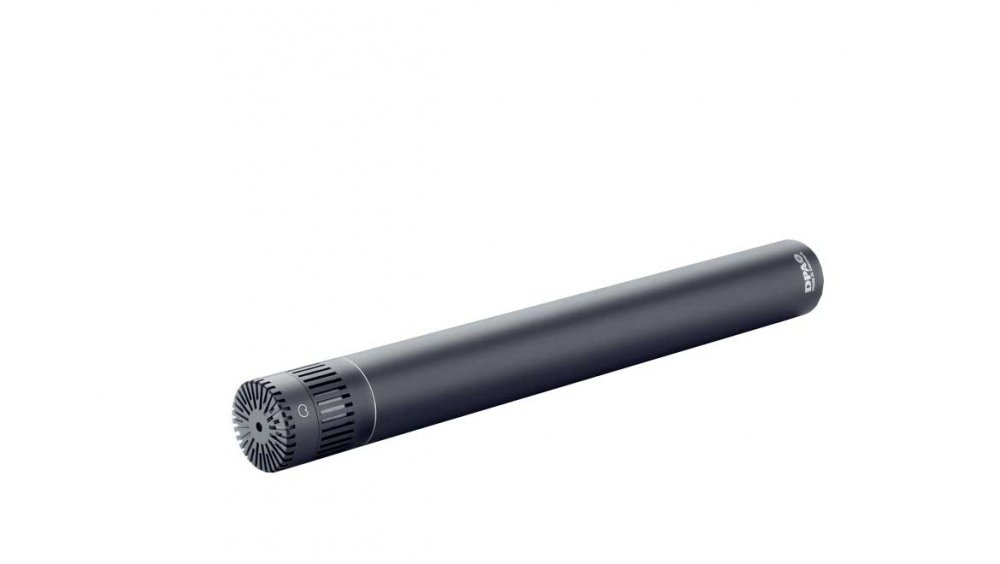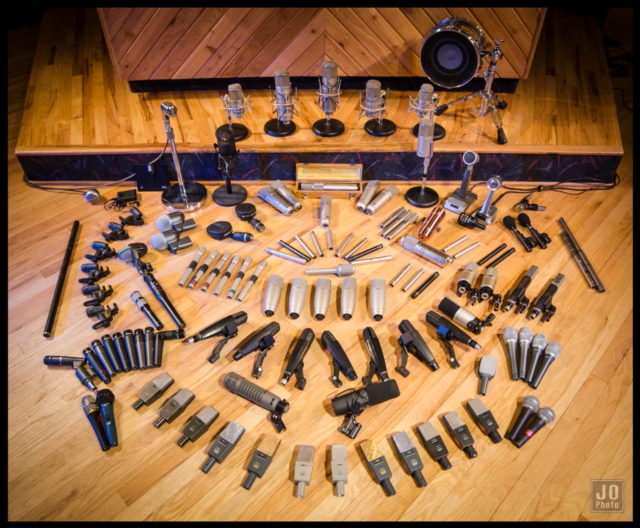Our music studios offer the greatest variety of microphone choices in the Denver metro area, with more than 85 microphones in our closet. We’ve already compiled a comprehensive list of all the microphones we offer in Studio A, Studio B, Studio W and our mobile studio, but I wanted to highlight some of the classics.
AKG C24

This classic tube microphone first appeared in 1959, essentially a stereo version of the of AKG C12. Today, the AKG C24 is world-renowned and used by thousands of artists both big and small.
The C24 stereo tube microphone possesses all the outstanding features of the C12 condenser microphone but is suitable for stereo applications. It incorporates two microphone capsules arranged closely one above the other, operating on separate outputs. Depending on the directional characteristic selected and the position of the two microphone capsules in relation to one another, MS or XY stereo pick up is possible.
The AKG C24 has a frequency response from 30Hz to 20kHz, each capsule has the ability to shift the polar pattern between cardioid, omni-directional, and figure eight. It’s a killer vocal microphone, but can be used in a variety of scenarios. I’d recommend giving it a try.
AKG C414

The AKG C414 has a long history, filled with many different designs, shapes, and transformers. This microphone is one of AKG’s most widely-known and our studio is lucky to boast that we have a wide-array of different 414’s for you to use. The modern 414 allows you to easily switch between multiple polar patterns, enable or disable a pad, and enable or disable a frequency roll-off.
The 414 is often described as “too bright” and other times as “too dark”. The microphone was known as too dark for most of its 50 year history and only in the early 90s when AKG changed one element that added the boost to the high-end did the thinking of this microphone as “too dark” change. Today, the important thing to remember with 414’s is that the gold-grilled model has a frequency peak that is better suited for vocals and the silver-grilled model is more neutral.
What we can tell you, is that it is a great microphone on acoustic guitars, Leslie cabinets, vocals, and more. You should definitely use this in your next session.
AMS ST250

Our studios offer a wide array of microphones, some you’ll commonly find in other professional studios, but we think the AMS ST250 is pretty unique. The ST250 is a mono and variable angle stereo microphone with a remote operated variable pickup pattern.
Contained within the microphone body are four capsules mounted in the shape of a pyramid. This setup, combined with the variable polar pattern control, allows the microphone to become entirely different microphones. Easily switching from omni, cardioid, figure-8 and everything in between. One of the key advantages to the ST250 is that you can point and shoot regardless of mode, making it easier to set up than other microphones, and you can do it all without worrying about phase cancellation between mono and stereo modes!
DPA 4011-TL

The 4011-TL is a small condenser microphone that has the ability to handle very high sound pressure levels, making it a great microphone choice for close miking techniques as well as distant miking. The 4011 is also resistant to fluctuating temperatures and humidity levels.
This microphone is ideal for pianos because you can get closer to the hammers. The 4011 boasts a neutral off-axis response, so that any leakage is still a reliable reproduction of the source. Phantom powered, transformerless (TL), and a 159dB SPL make this microphone a go-to tool in the engineer’s arsenal.
Placid Audio Copperphone

One of the more unique microphones in our extensive catalogue has to be the Copperphone. This dynamic cardioid microphone is unique in that it has a very limited frequency response, only 200Hz – 3kHz! This gives the microphone a nostalgic or vintage feeling like you are listening to an AM radio or talking to someone on the telephone.
As sound passes through the microphone it goes through a chamber that accentuates the midrange frequencies while simultaneously reducing the high frequencies. The Copperphone can be used as an all-out effect microphone, or it can be blended with a more traditional microphone to give you all kinds of creative results!
Royer R-121

The R-121 completely reengineered the classic ribbon microphone with today’s studio in mind. It has a flat frequency response and is able to withstand 135 dB SPL, allowing you to record it in places that were previously off-limits to ribbon microphones.
The R-121 was developed through relatively recent advancements in magnetics, materials and mechanical construction techniques. The ribbon element’s smooth frequency response and phase linearity, coupled with sensitivity levels surpassing those of “classic” ribbons, make this microphone an ideal choice for digital recording. The R121 delivers a consistent, natural acoustical performance with stunning realism. Widely used on electric guitars, brass instruments and drums, the R-121’s figure-8 pattern also conveys superb ambiance and depth when used for room miking applications, orchestral and choral recordings.
This microphone is perfect for acoustic guitars, guitar amplifiers, brass instruments, room miking, strings, piano, vocals, and more. But remember to handle it with care, it’s very sensitive to plosives
Shure SM7B

The Shure SM7b is one of those instant classic microphones, known for its versatility in both music and speech recording in all sorts of professional applications. It has a smooth, full-bodied sound and a wide ranging frequency response from 50Hz to 20kHz.
One thing to keep in mind with the Shure SM7b microphone is that the signal is often very low and you have to gain it significantly in some applications. To get around this, sometimes we will use a Cloudlifter. If you don’t know what a Cloudlifter is, it’s essentially a microphone preamp designed specifically for passive ribbon microphones and low-output dynamic microphones, such as the SM7b. Cloudlifters are an easy way to add more than 20dB of gain to your input, just plug and go. Try it next time you’re using your SM7b!
Neumann U47 with Klaus Heyne Modification

The Neumann U47 Tube microphone is one of the most famous microphones in the world. It was the first Neumann microphone built after World War II and it has been used by artists from Ella Fitzgerald to the Beatles, Michael Jackson to Adele. Equally at home in front of a singer, percussion instruments, or an acoustic guitar.
It was the first microphone to have a switchable pattern. In fact, the main difference between the U47 and U48 is the polar pattern options. The U47 has the option of cardioid or omni-directional, while the U48 can be cardioid or figure-8. However, apart from the polar pattern, the two microphones were almost identical.
The original U47’s used a Telefunken VF14 amplifier tube which was designed for the electrical grid (or lack thereof) of post-war Germany. When combined with the perfectly designed capsule and head-grille of the Neumann microphone the magic of the U47 was unleashed never to be duplicated.
The U47 and U48 have a frequency response from 30Hz to 15kHz with peaks at just the right frequencies to perfect the human voice. It has a rich and full tonality that is unmatched in the recording world.
It’s important to note that we’ve gone one step further here at Colorado Sound: Our particular U47 microphones have been meticulously modified by Klaus Heyne. A lot of times, the U47’s are noisy or don’t work in other studios, but since ours have been modified ours are much quieter and much more dependable.
Written by Kyle Dean

